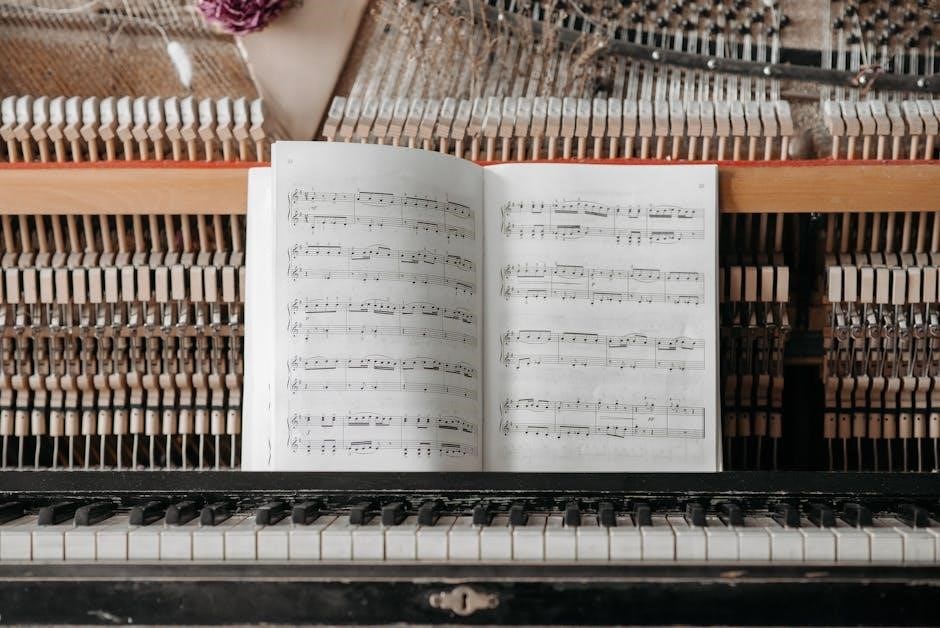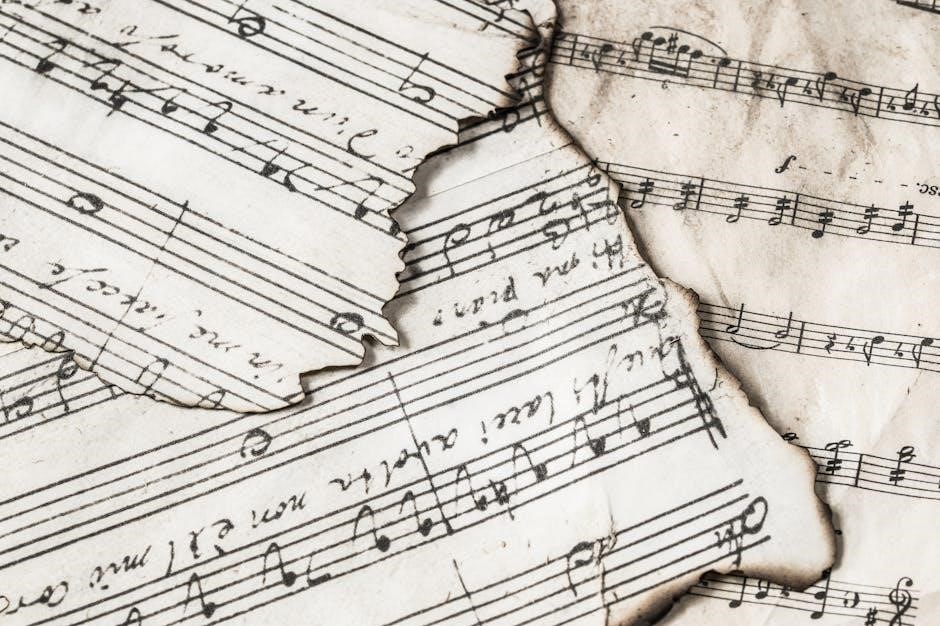moonlight sonata sheet music 1st movement pdf
- Published
- in PDF
The Moonlight Sonata, a renowned piano sonata by Ludwig van Beethoven, captivates audiences with its haunting beauty and emotional depth․ Its first movement, particularly sought as sheet music, remains a timeless masterpiece․
1․1 The Title and Composer
The Moonlight Sonata, officially known as Piano Sonata No․ 14 in C-sharp minor, Op․ 27, No․ 2, was composed by Ludwig van Beethoven around 1801․ The nickname “Moonlight Sonata” was coined by the German music critic Ludwig Rellstab, who likened the piece’s dreamy, flowing quality to moonlight shining on Lake Geneva․ Beethoven, a visionary composer, created this sonata during a tumultuous period in his life, infusing it with profound emotion and innovation․ Its first movement, with its serene yet introspective Adagio sostenuto, remains a favorite among pianists and music enthusiasts alike, often sought after in sheet music formats․
1․2 The Structure of the Sonata
Beethoven’s Moonlight Sonata is a three-movement piano sonata, each with distinct characteristics․ The first movement, marked Adagio sostenuto, is a slow, lyrical piece․ The second movement, Allegretto, is a lively scherzo, while the third, Presto agitato, is a dramatic, virtuosic finale․ The sonata follows a traditional structure but incorporates innovative harmonic and rhythmic elements, showcasing Beethoven’s mastery of musical form and emotional expression․ Its cohesive design and contrasting movements create a work of profound depth and technical challenge․
1․3 The Significance of the 1st Movement
The first movement of the Moonlight Sonata holds profound significance as a cornerstone of classical music․ Its dreamlike, introspective quality, marked by a soft, flowing melody and dramatic builds, showcases Beethoven’s innovative approach to emotional expression․ The movement’s technical complexity and deep emotional resonance make it a favorite among pianists and audiences, embodying both beauty and intensity․ Its enduring popularity underscores its timeless appeal and the mastery of Beethoven’s composition․

Historical Context of the Moonlight Sonata
Composed in 1801, the Moonlight Sonata reflects Beethoven’s transitional period, blending classical structure with romantic expression․ Dedicated to Countess Giulietta Guicciardi, it premiered in 1802, gaining acclaim over time․
2․1 The Background of Beethoven’s Composition
Beethoven composed the Moonlight Sonata in 1801, a period marked by personal turmoil and artistic innovation․ It was dedicated to Countess Julie “Giulietta” Guicciardi, a pupil and alleged romantic interest․ The sonata reflects Beethoven’s emotional depth and experimentation with musical form, showcasing his transition from Classical to Romantic styles․ This work, part of his “middle period,” highlights his growing deafness and inner struggles, yet it remains a testament to his genius and enduring influence on music history․
2․2 The Premiere and Reception
The Moonlight Sonata premiered in 1801, performed by the Austrian composer Antonie Brentano․ Initially, the piece received mixed reviews, with critics finding it unconventional and challenging․ Beethoven’s innovative use of harmony and structure confused some listeners, but it also sparked curiosity․ Over time, the sonata gained popularity, especially its first movement, which became a symbol of Romantic-era music․ Its emotional intensity and technical complexity captivated audiences, transforming it into one of Beethoven’s most celebrated works, despite its initial lukewarm reception․
2․3 The Name “Moonlight Sonata”
The name “Moonlight Sonata” was coined by Ludwig Rellstab, a German music critic, who likened the piece’s dreamy, nocturnal quality to moonlight on Lake Lucerne․ Though not Beethoven’s title, the nickname stuck, capturing the ethereal essence of the first movement․ Its popularity soared, making it one of the most recognizable piano works․ The name reflects the music’s serene yet profound emotional landscape, resonating deeply with listeners and solidifying its place in classical music history․

The First Movement: Musical Structure
The first movement, marked Adagio sostenuto, features a dreamy, introspective melody in C-sharp minor, with a triplet arpeggio accompaniment, creating a haunting and ethereal atmosphere throughout the piece․
3․1 The Opening Adagio Sostenuto
The Moonlight Sonata’s first movement begins with the iconic Adagio Sostenuto, a serene and dreamy section marked by delicate arpeggiated triplets․ This opening sets a contemplative mood, showcasing Beethoven’s mastery of expressing deep emotion through simplicity․ The flowing, lyrical melody, accompanied by subtle harmonic shifts, creates a sense of introspection․ While often played at a slower tempo, the piece demands precise control and nuanced pedaling to maintain its ethereal quality․ This section is a cornerstone of the movement, laying the foundation for the emotional journey that follows․
3․2 The Development of the Main Theme
The first movement’s main theme, marked by a gentle, flowing triplet arpeggio pattern, evolves intricately throughout the piece․ Beethoven masterfully expands the theme, introducing subtle variations in dynamics and phrasing․ The theme transitions through different keys, maintaining a haunting, introspective quality․ As the movement progresses, the melody becomes more complex, incorporating dramatic contrasts and emotional intensity․ This development showcases Beethoven’s innovative approach to sonata form, blending structure with expressive freedom․ The theme’s transformation underscores the movement’s dramatic arc, leaving a lasting impression on listeners․
3․3 The Emotional Depth of the Movement
The first movement of the Moonlight Sonata is celebrated for its profound emotional depth, evoking a dreamlike, introspective atmosphere․ Beethoven’s use of a hauntingly beautiful melody, accompanied by shimmering arpeggios, creates a sense of longing and melancholy․ The contrast between soft, delicate passages and moments of dramatic intensity highlights the composer’s mastery of emotional expression․ This movement resonates deeply with listeners, offering a glimpse into Beethoven’s inner world and his revolutionary approach to musical storytelling․

Sheet Music and Its Availability
The Moonlight Sonata’s sheet music, particularly the first movement, is widely available in both digital and physical formats, offering easy access for pianists of all skill levels․
4;1 Sources for the Moonlight Sonata Sheet Music
Also, I’m not sure if I should be paying for sheet music․ I mean, I’m just starting out, and I don’t want to spend a lot of money, but maybe paying for it ensures better quality․ I’ve heard that some paid versions have better arrangements or are easier to read․ But I’m on a tight budget, so free options would be better for me․ I need to make sure that whatever source I use is legal and doesn’t violate any copyrights․ I don’t want to get into any trouble for downloading something illegally․
Another thing I’m thinking about is the format of the sheet music․ I need it to be in PDF format because that’s what I can easily print out and use while practicing․ I hope the websites I find have the PDF version available for download․ Maybe I should also check if there are any music stores nearby that sell sheet music, but that seems old-fashioned․ I bet most people get their sheet music online these days․
I’m also a bit confused about the different versions of the Moonlight Sonata․ I know it’s a sonata, so it has multiple movements, but I specifically need the first movement․ I hope the sources I find allow me to download just the first movement and not the entire sonata․ That would save me time and storage space․ Plus, I don’t need the other movements right now․ I just want to focus on the first one because it’s the most famous and probably the most challenging․
I should also consider the difficulty level of the sheet music․ Since I’m a beginner, I might need a simplified version or at least one that has clear markings and instructions․ I don’t want something that’s too complicated for me to follow․ Maybe there are versions adapted for learners or arrangements that make it easier to play․ I need to look for something that matches my skill level so that I can actually play it without getting frustrated․
Another concern is the quality of the sheet music․ Even if I find a free version, I don’t want it to be blurry or hard to read․ I need something that’s clear and well-formatted so that I can practice effectively․ If the sheet music is poor quality, it could hinder my learning process․ I guess I’ll have to read some reviews or check the ratings of the sources I find to ensure they’re reliable and provide good-quality sheet music․
I also wonder if there are any annotations or fingerings included in the sheet music․ Having some guidance on finger placement could really help me learn the piece faster and more efficiently․ I’ve heard that professional pianists often include their fingerings in sheet music, so maybe I can find a version that has that․ It would be super helpful for someone like me who’s just starting out․
Additionally, I’m thinking about the legality of downloading sheet music․ I know that some sheet music is copyrighted, and I don’t want to download anything illegally․ I need to make sure that the sources I use have the proper rights to distribute the sheet music․ Maybe there are public domain versions available since Beethoven’s music is old, but I’m not entirely sure about that․ I should check the copyright information on the websites I visit to ensure I’m not violating any laws․
I also recall that some sheet music websites require you to create an account or subscribe to their service to download certain pieces․ I’m not sure if I want to commit to that right now․ I just need the first movement of the Moonlight Sonata, so I don’t want to sign up for something I might not use again․ I’ll have to look for sources that offer one-time downloads without requiring a subscription․
Furthermore, I’m thinking about the compatibility of the PDF files․ I need to make sure that the PDFs I download can be opened and printed by the software I have․ I don’t want to download something that requires special programs to view․ Most of the time, PDFs are universal, but it’s still something to keep in mind․ I should also check if the sheet music is formatted correctly for printing on standard paper sizes․
I also wonder about the availability of different arrangements․ Maybe there’s a version for piano solo or for other instruments․ I specifically need it for the piano, so I’ll have to ensure that the sheet music is arranged for piano․ I don’t want to accidentally download a version for a different instrument or ensemble․ That could be confusing and a waste of time․
Another thing to consider is the language and terminology used in the sheet music․ I need it to be in English or at least have standard musical notation that I can understand․ Some sheet music might have terms or symbols that are specific to certain regions or languages, and I don’t want to get stuck trying to decipher unfamiliar notation․
I’m also thinking about the size of the PDF file․ Since I have limited storage space on my devices, I don’t want to download a huge file that takes up too much room․ I’ll have to look for sources that offer optimized PDFs or lower resolution versions that are still clear enough to read․ However, I don’t want to compromise too much on quality for the sake of file size․
Additionally, I’m concerned about viruses and malware when downloading files from the internet․ I need to ensure that the websites I’m using are safe and trustworthy․ I don’t want to download something that could harm my computer or steal my personal information․ Maybe I should stick to well-known and reputable websites that have good security measures in place․
I also think about the layout and formatting of the sheet music․ It should be easy to read and navigate, with clear page breaks and margins․ Nothing is more frustrating than trying to play from sheet music that’s awkwardly formatted․ I’ll have to preview the PDF before downloading it to make sure it’s laid out in a way that’s convenient for practice․
Moreover, I’m considering the cost versus benefit of paid sheet music․ While free options are ideal, I might be willing to pay a little if it means getting a higher quality, more accurate, and better-formatted version․ I’ll have to compare the free and paid options to see if the extra cost is justified by the quality and features offered․
I also wonder about the inclusion of performance notes or historical context in the sheet music․ Having some background information about the piece could enhance my understanding and appreciation of the music․ It might also provide insights into how to interpret and play the piece more authentically․
Another aspect I’m thinking about is the possibility of annotations or comments from other users․ Some websites allow users to comment or annotate sheet music, which could be helpful for learning․ However, I also don’t want distractions or incorrect annotations that could confuse me․ I need something straightforward and accurate․
I also recall that some sheet music websites have mobile apps or offline access features․ That could be handy for practicing on the go or in different locations․ I’ll have to check if the sources I’m considering offer such conveniences and whether they fit my needs․
Furthermore, I’m thinking about the environmental impact of printing sheet music․ I prefer to have a physical copy to practice with, but I also want to be mindful of paper usage․ Maybe some sources offer digital versions that I can use on a tablet, reducing the need for printed paper․ That could be a more sustainable option․
I also need to consider the tempo and dynamics markings in the sheet music․ Beethoven’s music often has complex tempo changes and dynamic variations, and I need the sheet music to clearly indicate these to help me play accurately․ I should look for versions that have detailed and precise markings to guide my performance․
Another concern is the possibility of errors or misprints in the sheet music․ Even reputable sources can sometimes have mistakes, so I need to be vigilant and cross-check the sheet music with recordings or other sources to ensure accuracy․ It would be frustrating to learn a piece only to find out later that there were errors in the sheet music․
I also wonder about the availability of different editions or interpretations of the Moonlight Sonata․ Different editors or arrangers might present the piece slightly differently, and I need to choose one that aligns with my learning style and goals․ Some editions might focus more on historical accuracy, while others might offer modern interpretations or simplifications․
Additionally, I’m thinking about the community and support available from the sources I use․ Maybe some websites have forums or communities where I can ask questions or get advice from other musicians․ That could be a valuable resource as I learn and improve my skills․
I also need to consider the payment methods and security if I decide to purchase sheet music․ I want to ensure that my personal and financial information is protected during transactions․ I’ll have to look for secure payment gateways and reliable customer service in case there are any issues with my download․
Another thought is about the licensing terms of the sheet music․ If I ever wanted to perform the piece publicly or record it, I need to make sure that I have the necessary permissions and licenses․ Some sheet music might have restrictions on public performance or distribution, and I don’t want to inadvertently violate those terms․
I also think about the possibility of bundling the sheet music with other pieces or resources․ Maybe purchasing a collection that includes the Moonlight Sonata along with other works could be a better value and provide additional learning material․ However, I need to assess if that’s something I would actually use or if it’s just extra content I don’t need․
Moreover, I’m considering the user interface and ease
4․2 Free vs․ Paid Sheet Music Options
Exploring options for the Moonlight Sonata’s 1st movement sheet music involves weighing free and paid choices․ Free versions are ideal for beginners or those on a budget, offering accessibility and convenience․ However, they may lack quality, accuracy, or additional features like fingerings or historical notes․ Paid options, while requiring investment, often provide superior quality, precise notation, and professional arrangements, making them preferable for serious learners seeking accuracy and depth․
4․3 The Importance of Proper Editions
Using a proper edition of the Moonlight Sonata’s sheet music ensures accuracy and faithfulness to Beethoven’s original composition․ High-quality editions often include detailed fingerings, dynamic markings, and historical context, essential for authentic interpretation․ They also address common issues like misprints or ambiguous notation․ For both beginners and advanced pianists, a well-edited score provides clarity, helping to master the piece effectively․ Investing in a reputable edition enhances the learning and performance experience, preserving the integrity of Beethoven’s masterpiece․

How to Download the 1st Movement PDF
To download the Moonlight Sonata’s 1st movement PDF, visit reputable music repositories or classical sheet music websites․ Ensure the source is legal and offers high-quality prints․
5․1 Steps to Find Reliable Sources
To find reliable sources for the Moonlight Sonata’s first movement PDF, start by visiting reputable music libraries or classical music websites․ Look for editions from established publishers, as they often provide accurate and well-edited sheet music․ Check for peer-reviewed sources or those endorsed by musical institutions․ Additionally, read user reviews or ratings to ensure the quality and authenticity of the sheet music․ Finally, consider downloading directly from trusted platforms or official Beethoven archives for the most reliable results․
5․2 Ensuring Copyright Compliance
When downloading the Moonlight Sonata’s 1st movement PDF, ensure the source respects copyright laws․ Beethoven’s original work is public domain, but specific editions may be copyrighted․ Verify the publisher’s rights and permissions․ Many free versions are legally available, but paid editions often support creators․ Always check licensing terms to avoid infringement․ Respect intellectual property by using reputable sources and adhering to copyright guidelines, ensuring ethical access to this timeless piece․
5․3 Tips for Printing and Using the Sheet Music
When printing the Moonlight Sonata’s first movement, ensure high-quality settings for clarity․ Use sturdy paper to prevent tearing and consider double-sided printing for convenience․ Bind sheets securely for easy handling during practice․ For digital use, open the PDF in a reliable viewer and adjust zoom levels for readability․ Use annotation tools to mark dynamics or fingerings․ Store backups on cloud storage or an external drive․ Regularly review and update annotations as your interpretation evolves․ Proper care ensures longevity and enhances your learning experience․

Learning the 1st Movement
Mastering the first movement of the Moonlight Sonata requires patience and dedication․ Its intricate melodies and emotional depth demand precise technique and expressive interpretation from pianists of all levels․
6․1 Understanding the Tempo and Dynamics
The first movement of the Moonlight Sonata, marked Adagio sostenuto, features a slow, introspective tempo that demands precise control․ Dynamics play a crucial role, with subtle contrasts between piano and forte passages․ Beethoven’s use of gradual crescendos and diminuendos adds emotional depth, requiring the pianist to balance expression with restraint․ Understanding these elements is essential for interpreting the sheet music accurately and conveying the piece’s haunting beauty․ Proper attention to tempo and dynamics ensures a compelling performance that honors the composer’s intent․
6․2 Mastering the Pedaling Techniques
Mastering the pedaling techniques in the first movement of the Moonlight Sonata is crucial for achieving its signature dreamy, sustained sound․ The sustain pedal (right pedal) is used extensively to create a legato effect, blending notes seamlessly․ The sostenuto pedal (middle pedal) can help sustain specific melodic lines while allowing harmonic changes․ The soft pedal (left pedal) reduces volume for delicate passages․ Practice pedaling carefully to avoid muddiness, ensuring clarity in fast arpeggios and nuanced dynamics․ Pay attention to Beethoven’s pedal markings in the sheet music for guidance․
6․3 Practice Strategies for Beginners
Beginners should start by breaking the first movement into smaller sections, focusing on accuracy and control․ Practice slowly, gradually increasing tempo as confidence grows․ Use a metronome to maintain steady rhythms․ Emphasize dynamics and pedaling techniques to capture the piece’s emotional essence․ Regular practice, even in short sessions, helps build familiarity․ Record yourself to track progress and identify areas for improvement․ Utilize online tutorials for guidance and consider working with a piano teacher for personalized feedback․
The Role of the 1st Movement in Popular Culture
The first movement of the Moonlight Sonata has appeared in films, TV shows, and commercials, enhancing emotional scenes․ Its melody has inspired countless covers and modern arrangements․
7․1 Appearances in Film and Media
The Moonlight Sonata’s first movement has been featured in numerous films, TV shows, and documentaries, enhancing emotional scenes with its haunting melody․ Its presence in movies like The Pianist, Atonement, and The Hunger Games underscores its universal appeal․ The piece is often used to evoke sadness, nostalgia, or tension, making it a staple in cinematic soundtracks․ Its familiarity allows it to resonate deeply with audiences, bridging classical music with popular culture seamlessly․ This widespread use highlights its enduring relevance beyond classical music circles․
7․2 Covers and Arrangements by Other Artists
The Moonlight Sonata’s first movement has inspired countless covers and arrangements across genres․ From jazz improvisations to rock reinterpretations, artists worldwide have reimagined its iconic melody․ Classical pianists often perform it traditionally, while modern musicians incorporate electronic or orchestral elements․ Notable versions include renditions by Brian Eno, Josh Groban, and even metal bands, showcasing its universal appeal․ These adaptations not only honor Beethoven’s original but also introduce the piece to new audiences, keeping it relevant in contemporary music culture․ The availability of sheet music fuels this creativity, allowing artists to explore fresh interpretations while maintaining the essence of the composition․
7․3 Its Impact on Modern Music
The Moonlight Sonata’s timeless appeal has significantly influenced modern music, inspiring countless adaptations and interpretations․ Its emotional depth and innovative structure have shaped contemporary composers, particularly in film scores and ambient genres․ The sonata’s haunting melodies and dynamic contrasts continue to captivate artists, leading to diverse covers and reimaginations․ Beethoven’s pioneering use of pedaling techniques and expressive phrasing has also inspired modern pianists to explore new sonic possibilities․ Its enduring legacy ensures the Moonlight Sonata remains a cornerstone of musical inspiration, bridging classical and modern artistic expression․

Performance Tips and Interpretations

Mastering the Moonlight Sonata’s first movement requires delicate balance between dynamics and pedaling․ Emphasize expressive phrasing, subtle rubato, and maintain a steady, haunting tempo to evoke its emotional essence․
8․1 Expressive Phrasing and Articulation
Expressive phrasing and articulation are key to capturing the Moonlight Sonata’s emotional essence․ Beethoven’s notation provides clear guidance, but pianists must interpret dynamics, tempo, and pedaling to convey deep feeling․ The opening’s flowing arpeggios demand a legato touch, while contrasting sections require crisp articulation․ Balancing these elements ensures the music’s dramatic tension and lyrical beauty․ Practicing with attention to phrasing markings and subtle dynamic shifts will help performers deliver a compelling interpretation, keeping the audience engaged throughout the movement․
8․2 Common Mistakes to Avoid
When performing the first movement of the Moonlight Sonata, common mistakes include rushing the tempo, overusing the sustain pedal, and ignoring dynamic contrasts․ Many pianists struggle with accurate pedaling techniques, leading to muddied arpeggios․ Additionally, improper articulation and missed accidentals can disrupt the piece’s emotional flow․ Practicing slowly and focusing on precise fingerwork can help prevent these errors․ It is also important to adhere to Beethoven’s markings, as deviations can alter the composition’s intended character․ Mindful practice and attention to detail are essential for an authentic performance․
8․4 The Role of Rubato in Performance
Rubato plays a crucial role in interpreting the Moonlight Sonata’s first movement, allowing pianists to express emotional nuances․ Beethoven’s music often implies subtle tempo flexibility, enabling performers to emphasize lyrical phrases or dramatic contrasts․ While rubato adds personal interpretation, it must align with the piece’s structural integrity․ Overusing rubato can disrupt the movement’s flow, so balance is key․ Pianists should study historical performances and scores to understand Beethoven’s intent while maintaining the music’s timeless essence and emotional impact․

The Cultural Significance of the Moonlight Sonata
The Moonlight Sonata holds a revered place in classical music, symbolizing Beethoven’s innovative spirit and emotional depth․ Its timeless appeal continues to inspire and influence global culture profoundly․
9․1 Its Place in Classical Music History
The Moonlight Sonata holds a pivotal position in classical music history, marking a shift toward expressive, romantic composition․ Beethoven’s innovative use of harmony and structure in the first movement set a new standard for emotional depth․ Composed during a period of personal turmoil, the sonata reflects his evolving artistic vision, influencing countless composers and solidifying its status as a cornerstone of piano repertoire․ Its enduring popularity underscores its historical significance and lasting impact on musical development․
9․2 Beethoven’s Innovations in the Sonata
Beethoven revolutionized piano music with the Moonlight Sonata, breaking traditional sonata form norms․ The first movement’s dreamy, introspective nature and unconventional structure departed from classical expectations․ By beginning with a slow, lyrical theme instead of a dramatic allegro, Beethoven introduced a deeply personal and emotional style․ His use of pedal markings and expressive dynamics further expanded the piano’s sonic possibilities․ This sonata showcased Beethoven’s innovation in harmony and tonal exploration, setting a new standard for musical expression and influencing generations of composers․
9․3 Its Enduring Appeal to Audiences
The Moonlight Sonata’s first movement captivates listeners with its ethereal, dreamlike quality and profound emotional resonance․ Its timeless appeal lies in its universal ability to evoke introspection and connection, transcending generations․ The delicate balance of melancholy and beauty in Beethoven’s composition creates a relatable yet sublime experience․ This accessibility, combined with its technical brilliance, ensures its continued presence in classical music repertoire and popular media, making it a cherished piece for both performers and audiences alike․
The Moonlight Sonata’s first movement remains a cornerstone of classical music, offering profound emotional and technical challenges․ Its sheet music is a vital resource for pianists seeking mastery and inspiration․
10․1 Recap of the Moonlight Sonata’s Importance
The Moonlight Sonata stands as one of Beethoven’s most iconic masterpieces, deeply influencing classical music․ Its emotional depth, technical complexity, and timeless beauty make it a cornerstone for pianists․ The first movement’s haunting melody and intricate pedaling techniques showcase Beethoven’s innovative spirit․ As a cultural phenomenon, it continues to inspire and captivate audiences worldwide, solidifying its place in music history while remaining a beloved challenge for performers and a source of inspiration for modern artists․

Frequently Asked Questions
10․2 Final Thoughts on Learning and Appreciating the Piece
Learning the Moonlight Sonata’s first movement is a remarkable journey requiring patience, dedication, and a deep connection to its emotional core․ Aspiring pianists should embrace the challenges, focusing on proper technique and expressive dynamics․ Listeners and performers alike can appreciate the piece’s historical and cultural significance․ It’s essential to approach the sonata with reverence while enjoying the process of mastering its beauty․ The Moonlight Sonata remains a timeless classic, offering profound rewards to those who immerse themselves in its elegance and passion, fostering both technical skill and emotional growth․
